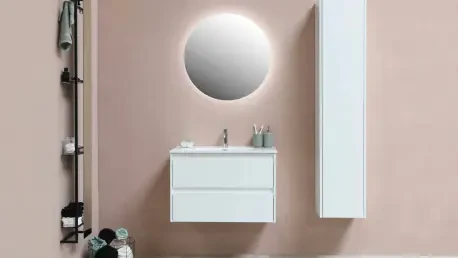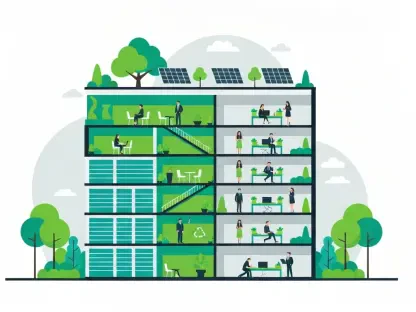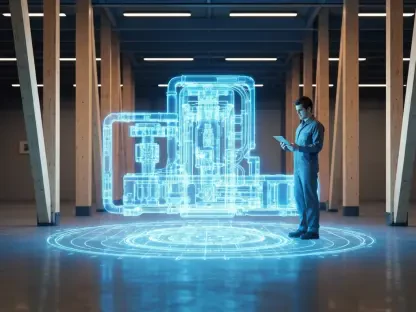With a noticeable shift in interior design trends, the aesthetic approach to bathroom colors is undergoing a significant transformation. Unlike previous years that saw a dominance of cool and neutral tones, contemporary designs are leaning towards vibrant and warm hues to enhance the comfort and visual appeal of bathroom spaces. This change is driven by the desire to create inviting environments that are both functional and pleasing to the eye. Experts in the field of interior design and color psychology are championing this movement, offering insights into the benefits and application of richer colors that add personality and depth to bathrooms.
Rising Trends in Bathroom Colors
Interior experts predict a significant shift from the icy blues and cool-toned blues, which have long been staples in bathroom design. These shades are now increasingly viewed as too cold and unwelcoming for bathroom spaces where comfort and relaxation are key. Instead, rich and bold hues are being recommended to introduce depth and personality. This trend reflects a broader move in interior design towards creating more inviting and dynamic spaces that break away from the clinical and sterile feel often associated with cooler color palettes.
The preference for richer colors is also influenced by the move towards more personalized and expressive spaces. Modern homeowners are looking to infuse their bathrooms with colors that not only reflect current trends but also their own aesthetic preferences and lifestyles. This trend towards personalization is leading to a greater acceptance of adventurous color choices and a departure from the safe, neutral tones of the past.
Avoiding the Chill of Cool Blues
Cool-toned blues, particularly icy shades, are gradually being replaced in favor of warmer alternatives. These cooler shades can often leave a sterile and cold impression, which is less desirable in today’s bathroom aesthetics. The new approach recommends the use of textured materials and playful patterns to instill warmth and charm in bathroom spaces. For instance, grasscloth wallpapers and bold floral or geometric prints are becoming popular choices for adding personality and a sense of coziness.
Using textured materials and intricate patterns not only adds visual interest but also helps to soften the overall look of the bathroom. This approach aligns with the trend towards creating spaces that are not just functional but also aesthetically engaging and comforting. By avoiding the chill associated with cool blues, designers are able to craft environments that feel more welcoming and conducive to relaxation.
Revisiting Neutral Palettes
The longstanding trend of using neutral tones in bathroom design is being reconsidered. While traditionally seen as a versatile and safe choice, these colors can often lack the ability to add depth and distinct character to bathroom spaces. In contrast, deeper, moody hues such as smoky mid-tones are being promoted for their dramatic appeal and ability to transform a bathroom into a more stylish and inviting environment. Experts like Arianna Barone, Color Marketing Manager at Benjamin Moore, suggest that these richer tones can bring an element of sophistication and warmth that lighter neutrals often fail to deliver.
The move away from ‘safe’ neutrals is part of a larger trend towards more adventurous and expressive design choices. Homeowners are increasingly looking to make a statement with their bathroom decor, and this includes opting for colors that stand out and add a touch of luxury and personality. By revisiting neutral palettes and embracing deeper hues, bathrooms can be transformed into spaces that feel both modern and timeless.
Transition from Gray
Gray tones, which have been a popular choice in bathroom designs, are now being phased out due to their tendency to create an industrial and uninviting atmosphere. While gray can be a versatile and sophisticated color, it can also be challenging to work with, as it often pulls unwanted undertones and can make spaces feel cold. As a result, warmer neutrals and earthy tones are now considered better options to evoke a cozy and inviting feel in bathroom spaces.
Designers are recommending shades like Benjamin Moore’s Balboa Mist or Collingwood, which offer a softer, warmer alternative to the cool grays of the past. These colors help to create a more welcoming environment while still maintaining a modern and elegant aesthetic. By moving away from the cool, industrial feel of gray, bathrooms can be transformed into spaces that are not only functional but also comfortable and inviting.
The Warmth of White
Cool whites, which were once popular for their clean and minimalist look, are now seen as too stark and clinical. These cooler shades can often make a bathroom feel overly bright and unwelcoming, especially when paired with glossy finishes. Instead, warm whites are being suggested as alternatives that maintain brightness while creating a softer and more welcoming ambiance. Colors like Benjamin Moore’s Cloud White offer a more inviting and comfortable feel, without sacrificing the light and airy quality that white walls can provide.
Warm whites help to balance the harshness of the bathroom’s clean lines and hard surfaces, creating a more harmonious and pleasant environment. This shift towards warmer whites is part of a broader trend in interior design that emphasizes comfort and coziness, even in traditionally minimalist spaces. By opting for warm whites, designers can achieve the best of both worlds: a bright and airy space that also feels inviting and soothing.
Bold and Moody Hues
Embracing bolder colors such as deep reds and luxurious greens is another trend that’s gaining traction in bathroom design. These rich, moody hues offer a sophisticated look and transform bathrooms into stylish, indulgent spaces. Colors like oxblood, claret, and dark green are being highlighted for their ability to add depth and character, making a bathroom feel more luxurious and personalized.
Using bolder hues can create a dramatic and striking effect in the bathroom, turning it into a space that is not just functional but also visually captivating. These colors can be used in various elements, from wall paint to tiles and accessories, creating a cohesive and impactful design. By incorporating richer tones, bathrooms can be elevated to a new level of elegance and style.
Material Drenching Design Approach
One innovative approach to bathroom design is the concept of ‘material drenching,’ where the same color scheme is extended across various elements to create a cohesive and luxurious feel. This technique involves matching the wall color with tiles, fixtures, and even accessories, creating a harmonized and immersive environment. Deep reds, greens, and other bold colors lend themselves particularly well to this approach, as they add a sense of unity and sophistication.
Material drenching allows for a seamless and polished look that feels deliberate and well thought out. It’s an effective way to create a statement in the bathroom, making it a space that feels both cohesive and luxurious. By carefully selecting and coordinating colors across different materials and surfaces, designers can achieve a harmonious and visually stunning result.
Practical Insights and Contemporary Alternatives
There’s a noticeable shift happening in interior design trends, specifically concerning bathroom colors, which are undergoing a remarkable transformation. Unlike past years, where cool and neutral tones were the go-to choice, today’s designs are embracing vibrant and warm hues. This shift aims to enhance the comfort and visual appeal of bathroom spaces, making them more inviting and lively. The change is motivated by the desire to create spaces that are not only functional but also aesthetically pleasing. Interior design experts and color psychology specialists are advocating for this trend, showcasing the advantages and implementation of richer, more dynamic colors. They explain that these hues can bring a unique personality and depth to bathrooms, making them places where people enjoy spending time. This new approach suggests that adding vibrant colors can turn a simple, utilitarian space into a comforting retreat. The trend represents a broader movement toward creating more personalized and engaging environments within our homes.









